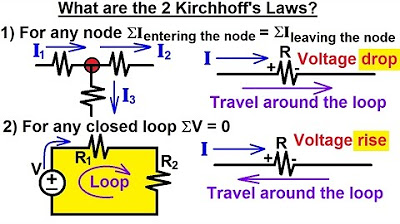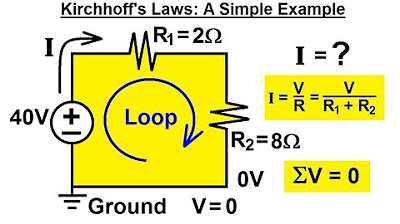Elektronika Dasar 002 Resistor 02 Universitas Jember
Summary
TLDRThis video script provides a comprehensive explanation of Kirchhoff's Voltage Law (KVL) and Kirchhoff's Current Law (KCL) in electrical circuits. It demonstrates how to apply KVL to series circuits to derive the total resistance as the sum of individual resistances. The script also covers KCL in parallel circuits, where the sum of currents entering a junction equals the sum of those leaving. Through practical examples and calculations, the script illustrates how to determine total current and equivalent resistance, emphasizing the use of Ohm's Law for solving circuit problems. It's a detailed and instructional guide for learning basic circuit analysis.
Takeaways
- 😀 Kirchhoff's Voltage Law (KVL) states that the total voltage in a closed circuit is the sum of the individual voltages across components.
- 😀 Ohm's Law is used to relate voltage, current, and resistance in a circuit, with the formula V = IR.
- 😀 In a series circuit, the total resistance is the sum of individual resistances (R_total = R1 + R2).
- 😀 Kirchhoff's Current Law (KCL) asserts that the sum of currents entering a junction equals the sum of currents leaving it.
- 😀 The direction of current flow is crucial when applying KCL; currents flowing into a point are positive, while currents leaving are negative.
- 😀 Resistor combinations can be simplified using KVL and KCL to determine the overall resistance in a circuit.
- 😀 The total current in a parallel circuit is the sum of the currents through each branch (I_total = I1 + I2 + I3).
- 😀 To find the total current in a parallel circuit, divide the voltage across the branches by the resistance in each branch.
- 😀 The formula for the total resistance in a parallel circuit is 1/R_total = 1/R1 + 1/R2 + 1/R3.
- 😀 Using KCL and KVL together, we can derive equations that relate voltage and current to solve for unknowns in complex circuits.
Q & A
What is Kirchhoff's Voltage Law (KVL)?
-Kirchhoff's Voltage Law (KVL) states that the sum of all voltages around a closed loop in a circuit is equal to zero. This is because energy is conserved, and the total energy gained in a loop must equal the total energy lost.
How do you apply KVL in a simple series circuit with two resistors?
-In a simple series circuit with two resistors, the total voltage across the circuit is the sum of the individual voltage drops across each resistor. Using Ohm’s Law, these voltage drops can be expressed as V1 = I * R1 and V2 = I * R2. Therefore, the total voltage V_total = V1 + V2 = I * (R1 + R2).
What is the relationship between the total resistance in a series circuit and individual resistances?
-In a series circuit, the total resistance is simply the sum of the individual resistances. So, if you have resistors R1 and R2 in series, the total resistance is R_total = R1 + R2.
What does Kirchhoff's Current Law (KCL) state?
-Kirchhoff's Current Law (KCL) states that the total current entering a junction in a circuit is equal to the total current leaving that junction. This law reflects the conservation of electric charge.
How do you apply KCL to a junction with multiple currents?
-If you have a junction where currents I1, I2, and I3 are entering and I4 is leaving, you can use KCL to write the equation: I4 = I1 + I2 + I3. This ensures that the current entering the junction equals the current leaving.
What is the formula for the total resistance in a parallel circuit?
-The formula for the total resistance in a parallel circuit with three resistors R1, R2, and R3 is given by: 1/R_total = 1/R1 + 1/R2 + 1/R3. This shows how the total resistance decreases as more resistors are added in parallel.
How does KCL help in solving circuit problems?
-KCL helps in solving circuit problems by allowing you to relate the currents at different junctions in a circuit. It simplifies complex circuits by setting up equations based on the sum of currents at each node.
Why is the current through each resistor in a parallel circuit different?
-The current through each resistor in a parallel circuit is different because each resistor has its own resistance. According to Ohm's Law, the current is inversely proportional to the resistance, so lower resistance will allow more current to flow.
How can you calculate the current through each resistor using Ohm’s Law?
-To calculate the current through each resistor, you use Ohm’s Law, I = V/R. For example, if you know the voltage (V) and the resistance (R) for a particular resistor, you can calculate the current by dividing the voltage by the resistance.
What does the equation 1/R_total = 1/R1 + 1/R2 + 1/R3 tell us about resistors in parallel?
-The equation 1/R_total = 1/R1 + 1/R2 + 1/R3 tells us that the total resistance in a parallel circuit is always less than the smallest individual resistance. This is because the current has multiple paths to flow through, reducing the total resistance.
Outlines

This section is available to paid users only. Please upgrade to access this part.
Upgrade NowMindmap

This section is available to paid users only. Please upgrade to access this part.
Upgrade NowKeywords

This section is available to paid users only. Please upgrade to access this part.
Upgrade NowHighlights

This section is available to paid users only. Please upgrade to access this part.
Upgrade NowTranscripts

This section is available to paid users only. Please upgrade to access this part.
Upgrade NowBrowse More Related Video

KVL and KCL (Circuits for Beginners #11)

Electrical Engineering: Basic Laws (8 of 31) What Are Kirchhoff's Laws?

Kirchhoff's Voltage Law (KVL) - How to Solve Complicated Circuits | Basic Circuits | Electronics

Chapter 2 - Fundamentals of Electric Circuits

Kirchhoff's Voltage Law (KVL) Explained

Electrical Engineering: Basic Laws (9 of 31) Kirchhoff's Laws: A Simple Example
5.0 / 5 (0 votes)